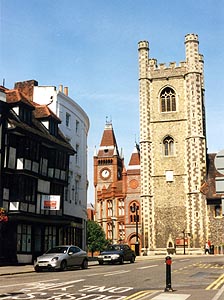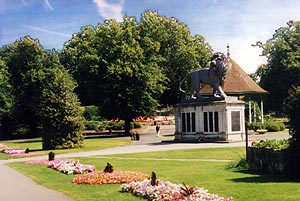
RBH Home
Maps & Travels
Articles
Legends
Towns & Villages
Castles & Houses
Churches
Biographies
Gentry
Family History
Odds & Ends
Mail David
Reading
Biscuits, Bulbs & Beer
 Reading
is the county town of Berkshire and must be a high contender for the much
disputed title of shopping capital of the South of England. With the
recent completion of the enormous 'Oracle' Shopping Mall, the retail heart
of the town now stretches in a vast swathe from the River Kennet to
Reading Central Station, even moving up towards the Thames at Caversham.
You can find all the major shops in Reading, including three enormous
Department Stores. There are also innumerable smaller vendors
and specialist shops, like the Delicatessen in 'the Butts,' renowned for
its unusual cheeses from around the Country. The town is a pleasant place
to shop, though sometimes rather crowded. The main, 'Broad Street' is
mostly pedestrianized now and there is plenty of room for children's
entertainment and street performers in the Summer. Down at the Oracle, the
River Kennet is lined with restaurants and cafes as well as a multi-screen
cinema: An ideal place to take a break and grab something to eat. A walk
along the River will also bring you to the fascinating Blakes Lock Museum
in an old Pumping Station. Here you can explore Reading's commercial,
industrial and waterways heritage. Exhibits include full-scale Victorian
shops and a locally-made Gypsy Caravan. There is plenty of parking at the
Oracle, the Broad Street Mall, Queen's Road and elsewhere. Reading is, of
course, one of the country's main railway junctions; but there are also
park and ride scheme operating, on Saturdays, from the Shire Hall, the
Showcase Cinema Complex at nearby Winnersh and Reading Football Club's new
Madejski Stadium. The latter boasts out-of-town shopping facilities off
the nearby Basingstoke Road.
Reading
is the county town of Berkshire and must be a high contender for the much
disputed title of shopping capital of the South of England. With the
recent completion of the enormous 'Oracle' Shopping Mall, the retail heart
of the town now stretches in a vast swathe from the River Kennet to
Reading Central Station, even moving up towards the Thames at Caversham.
You can find all the major shops in Reading, including three enormous
Department Stores. There are also innumerable smaller vendors
and specialist shops, like the Delicatessen in 'the Butts,' renowned for
its unusual cheeses from around the Country. The town is a pleasant place
to shop, though sometimes rather crowded. The main, 'Broad Street' is
mostly pedestrianized now and there is plenty of room for children's
entertainment and street performers in the Summer. Down at the Oracle, the
River Kennet is lined with restaurants and cafes as well as a multi-screen
cinema: An ideal place to take a break and grab something to eat. A walk
along the River will also bring you to the fascinating Blakes Lock Museum
in an old Pumping Station. Here you can explore Reading's commercial,
industrial and waterways heritage. Exhibits include full-scale Victorian
shops and a locally-made Gypsy Caravan. There is plenty of parking at the
Oracle, the Broad Street Mall, Queen's Road and elsewhere. Reading is, of
course, one of the country's main railway junctions; but there are also
park and ride scheme operating, on Saturdays, from the Shire Hall, the
Showcase Cinema Complex at nearby Winnersh and Reading Football Club's new
Madejski Stadium. The latter boasts out-of-town shopping facilities off
the nearby Basingstoke Road.
Today the town is probably most famous for its annual music festival in July. The arts continue throughout the year at 'The Hexagon' Theatre, the Thames-Valley's major centre for big-name plays and concerts. Though not best known for historic buildings or tourist attractions, Reading, nevertheless, has hidden gems of this genre too. The museum in the stylish Victorian Town Hall will point you in the right direction. This treasure house of modern displays explains both the History of Reading and the Roman town of Silchester, not far to the south. This is one of the few such towns which have not been built upon in more recent centuries and was therefore open for complete excavation at the end of the 19th century. The vast collection of Roman artefacts at Reading are the result: from children's games to a bronze eagle - some think from a Military Standard! The pride of the museum is the only full length replica of the Bayeaux Tapestry to be seen in the UK.
 Reading
was once the site of one of the greatest monastic foundations in the
Country, second only to Glastonbury and St. Albans. Reading was a rich and
popular place of pilgrimage in medieval times having the hand of St. James
enshrined within its walls. Henry I was even buried there. The sorrowful
ruins can be found behind the museum and over the inner ring-road in the
beautiful Forbury Gardens. Dominated by the biggest sculptured
lion in the
World, this is a popular spot for lunch-time picnics. The ruins are well
looked after and nicely displayed with explanatory boards. Hidden away are
the shells of the south
transept, the chapter house and other associated
buildings. The much restored Abbey Gateway stands in the adjoining road
and the guest-house can be seen in the churchyard of St.
Lawrence. This
fascinating old church was built by the Abbey monks and is usually open to
the public on Saturdays. Other churches of interest are St.
Mary's, near
the Oracle, Greyfriars (a restored Friary), near the Station, and St.
Giles', a little out of town. They are rarely open. There are some old
pubs in Castle Street and some fine Georgian buildings in London Street
which heads up towards the University on the south side of the town. Here
you will find the Museum of English Rural Life, the country's premiere
collection of artefacts and archives relating to country life. Housed in
its own building, just within the beautiful Whiteknights
Park, the
museum's emphasis is on farming and other rural industries. Just the place
to step back into the lives of our ancestors. The Cole Museum of Zoology
and the Ure Museum of Classical Archaeology are less accessible within
their relevant faculties.
Reading
was once the site of one of the greatest monastic foundations in the
Country, second only to Glastonbury and St. Albans. Reading was a rich and
popular place of pilgrimage in medieval times having the hand of St. James
enshrined within its walls. Henry I was even buried there. The sorrowful
ruins can be found behind the museum and over the inner ring-road in the
beautiful Forbury Gardens. Dominated by the biggest sculptured
lion in the
World, this is a popular spot for lunch-time picnics. The ruins are well
looked after and nicely displayed with explanatory boards. Hidden away are
the shells of the south
transept, the chapter house and other associated
buildings. The much restored Abbey Gateway stands in the adjoining road
and the guest-house can be seen in the churchyard of St.
Lawrence. This
fascinating old church was built by the Abbey monks and is usually open to
the public on Saturdays. Other churches of interest are St.
Mary's, near
the Oracle, Greyfriars (a restored Friary), near the Station, and St.
Giles', a little out of town. They are rarely open. There are some old
pubs in Castle Street and some fine Georgian buildings in London Street
which heads up towards the University on the south side of the town. Here
you will find the Museum of English Rural Life, the country's premiere
collection of artefacts and archives relating to country life. Housed in
its own building, just within the beautiful Whiteknights
Park, the
museum's emphasis is on farming and other rural industries. Just the place
to step back into the lives of our ancestors. The Cole Museum of Zoology
and the Ure Museum of Classical Archaeology are less accessible within
their relevant faculties.
Next: Newbury
